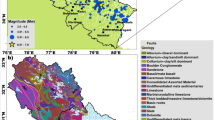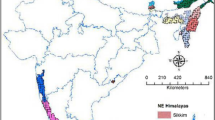Abstract
The seismic ground motion hazard is mapped in the Sikkim Himalaya with local and regional site conditions incorporated through geographic information system. A strong motion network in Sikkim comprising of 9 digital accelerographs recorded more than 100 events during 1998–2002, of which 41 events are selected with signal-to-noise ratio ≥3 for the estimation of site response (SR), peak ground acceleration (PGA) and predominant frequency (PF) at all stations. With these and inputs from IRS-1C LISS III digital data, topo-sheets, geographical boundary of the State of Sikkim, surface geological maps, soil taxonomy map in 1:50,000 scale and seismic refraction profiles, the seismological and geological thematic maps, namely, SR, PGA, PF, lithology, soil class, %slope, drainage, and landslide layers are generated. The geological themes are united to form the basic site condition coverage of the region. The seismological themes are assigned normalized weights and feature ranks following a pair-wise comparison hierarchical approach and later integrated to evolve the seismic hazard map. When geological and seismological layers are integrated together through GIS, microzonation map is prepared. The overall site response, PGA and predominant frequency show an increasing trend in the NW–SE direction peaking at Singtam in the lesser Himalaya. As Main Boundary Thrust (MBT) is approached, the attribute value increases further. A quasi-probabilistic seismic hazard index has been proposed based on site response, peak ground acceleration and predominant frequency. Six seismic hazard zones are marked with percent probability <22%, 22–37%, 37–52%, 52–67%, 67–82%, >82% at 3 Hz and <20%, 20–34%, 34–48%, 48–61%, 61–75%, >75% at 9 Hz. In the microzonation vector layer of integrated seismological and geological themes also six major zones are mapped, with percent probability <15%, 15–31%, 31–47%, 47–63%, 63–78%, >78% at low frequency end. The maximum risk is attached to the probability greater than 78% in the Singtam and its adjoining area. These maps are generally better spatial representation of seismic hazard including site-specific analysis.
Similar content being viewed by others
References
Andrews, D. J.: 1986, Objective determination of source parameters and similarity of earthquakes of different size, Earthquake Source Mechanics, American Geophysical Union, Washington D.C., pp. 259–268.
Bilham, R., Gaur, V. K., and Molnar, P.: 2001, Himalayan seismic hazard, Science 293, 1442–1444.
Boatwright, J., Flectcher, J. B., and Fumal, T. E.: 1991, A general inversion scheme for source, site and propagation characteristics using multiply recorded sets of moderate-sized earthquakes, Bull. Seism. Soc. Am. 81, 1754–1782.
Borcherdt, R. D.: 1970, Effects of local geology on ground motion near San Francisco Bay, Bull. Seism. Soc. Am. 60, 29–61.
De, R.: 2000, A microearthquake survey in the Himalayan Foredeep region, Sikkim Himalaya, J. Geophysics XXI, 1–8.
Gansser, A.: 1964, Geology of Himalayas, Interscience Publ., New York, 28 pp.
Kayal, J. R.: 2001, Microearthquake activity in some parts of the Himalaya and the tectonic model, Tectonophysics 339, 331–351.
Nath, S. K., Sengupta, P., Sengupta, S., and Chakarabarti, A.: 2000, Site response estimation using Strong Motion network: A step towards microzonation of Sikkim Himalayas, Seismology 2000, Current Science 79, 1316–1326.
Nath, S. K., Sengupta, P., and Kayal, J. R.: 2002, Determination of site response at Garhwal Himalaya from the aftershock sequence of 1999 Chamoli Earthquake, Bull. Seism. Soc. Am. 92, 1072–1081.
National Bureau of Soil Survey: 1994, Master plan for irrigation development, Sikkim, Govt. of Sikkim, Agricultural Finance Corporation Ltd., Report 2, 35–47.
Neogi, S., Dasgupta, S., and Fukuoka, M.: 1998, High P-T polymetamorphism, dehydration melting, and generation of migmatites and granites in the higher Himalayan crystalline complex, Sikkim, India, Journal of Petrology 38, 61–99.
Shahid, S., Nath, S. K., and Kamal, A. S. M. M.: 2002, GIS integration of remote sensing and topographic data using fuzzy logic for ground water assessment in Midnapur District, India, Geo-carto International (in press).
Author information
Authors and Affiliations
Rights and permissions
About this article
Cite this article
Kumar Nath, S. Seismic Hazard Mapping and Microzonation in the Sikkim Himalaya through GIS Integration of Site Effects and Strong Ground Motion Attributes. Natural Hazards 31, 319–342 (2004). https://doi.org/10.1023/B:NHAZ.0000023355.18619.0c
Issue Date:
DOI: https://doi.org/10.1023/B:NHAZ.0000023355.18619.0c




